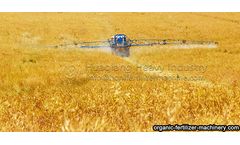Legumes Crop Articles & Analysis
13 articles found
Tackling Malawi's Hidden Hunger through Selenium and Iodine biofortification to green vegetables and conservation agriculture (CA) field crops Introduction In sub-Saharan Africa, micronutrient deficiencies are common in poor and rural areas, due to over-farmed, depleted soils and restricted diets. In Malawi, three-quarters of the population are selenium-deficient, which can lead to weakened ...
Reasonable rotation and increase the planting area of legumes. A crop of legume can increase the content of nitrogen in the soil during four years of rotation. ...
These rhizobacteria normally provide fertilizer to legume crops such as common beans and chickpeas, and those have been the focus of the research so far, but it may be possible to adapt them to work with other kinds of crops as well, and that is part of the team's ongoing research. "There is a big push to extend the use of rhizobacteria to ...
At Abbots Ripton for example, the soils are heavy, boulder clays and so are more suitable for combinable crops. “Typically, the rotation consists of two wheats, followed by either oilseed rape or beans. The rest is generally fenland which means we can grow potatoes, as well as other root crops and legumes,” says Mr Drinkwater. He ...
.* Newton Lupwayi and his research team work with legumes and pulses in Alberta, Canada. Alberta has terrific conditions for pulse crops: good soil (and microbes), good average temperatures, and good average rainfall. ...
The majority of food consumed is from cereals and legumes. Phosphorus is essential for crop plant growth and soils are depleted as this element is removed from crop lands with harvested grains/seeds. ...
Inclusion of a winter legume cover crop into a crop rotation has been suggested as a method to provide a substantial portion of the N requirement of the following crop. While the benefits of winter cover crops such as reduced soil erosion, increased soil organic matter, and increased mulch cover have been well ...
This decline is in agreement with numerous long-term baseline data sets from chemical-based cropping systems involving a wide variety of soils, geographic regions, and tillage practices. ...
A 2-yr study was conducted on organic farms in Salinas and Hollister, CA, to evaluate the effect of seeding rate (SR) and planting arrangement on cover crop density, ground cover, and cover crop and weed dry matter (DM) with a mixed cover crop. ...
Lentil, Lens culinaris subsp. culinaris Medic., is an important legume crop on the Canadian prairies. Anthracnose, a fungal disease caused by Colletotrichum truncatum (Schwein.) ...
Moench] and soil total N (STN) content at the 0- to 120-cm depth in no-tilled, strip-tilled, and chisel-tilled Dothan sandy loam (fine-loamy, kaolinitic, thermic, Plinthic Kandiudults) from 2000 to 2002 in central Georgia. Cover crops were legume [hairy vetch (Vicia villosa Roth)], nonlegume [rye (Secale cereale L.)], biculture of legume and ...
Rhizobia from these legumes formed nodules on the roots of Vigna mungo except isolates from Albizia lebbeck. ...
Cropping systems in the Northern Great Plains have shifted from fallow-based to legume-based systems. ...








